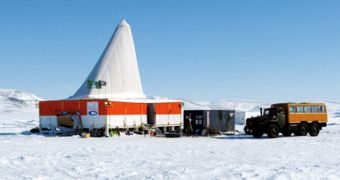After nearly a decade of investigations, an international collaboration of scientists has finally be able to obtain the most continuous record of how climate on ancient Earth looked like.
The core samples that give these informations were extracted from the terrestrial Arctic. The study had a price tag of about $10 million, and enlisted the help of engineers that usually build ice roads for trucks in Canada.
This particular climate record has been obtained by core sampling sediment layers located underneath the bottom of a lake in northeastern Siberia, in the Russian Federation.
As an added bonus, the researchers who conducted the study say that the effort also resulted in the discovery of an impact crater, that was produced when a large meteorite slammed into our planet.
According to the earliest results of age dating, it would appear that the impact took place about 3.6 million years ago. The core samples can tell researchers what happened immediately afterwards.
The location where the digs were made is a barren tundra today, but in the past it was a warm habitat, covered in forests, and featuring a complex ecosystem of species. After the impact, the crater was filled with water, and Lake El’gygytgyn was formed.
“We’re really pleased that we have a complete record of that entire time period,” says of the achievement geologist Julie Brigham-Grette, who holds an appointment at the University of Massachusetts in Amherst.
The investigator was also one of the leaders of the new research initiative. She presented details of the discoveries on October 31, at the annual meeting of the Geological Society of America, in Denver.
The core samples provide an uninterrupted view of how warm and cool periods alternated at the location over the past few million years. These data can be correlated with information obtained from other sites in the Arctic Ocean and in Antarctica.
Experts hope that these connections will allow them to gain a more detailed perspective of how Earth looked like millions of years ago, and how temperatures fluctuated in time, Science News reports.
This investigation could therefore be very important for modeling the planet's climate in the future. Knowing how ice ages alternated with periods of global warming is important for understanding just how much damage we are currently doing to the planet.
The reason why a stud such as the one at Lake El’gygytgyn was not conducted before is purely practical. “The sheer logistics prevented anyone from doing this before,” Brigham-Grette told peers in Denver.

 14 DAY TRIAL //
14 DAY TRIAL //